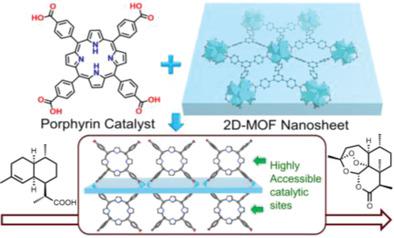Our official English website, www.x-mol.net, welcomes your
feedback! (Note: you will need to create a separate account there.)
Photosensitizer‐Anchored 2D MOF Nanosheets as Highly Stable and Accessible Catalysts toward Artemisinin Production
Advanced Science ( IF 14.3 ) Pub Date : 2019-04-09 , DOI: 10.1002/advs.201802059 Ying Wang 1, 2 , Liang Feng 3 , Jiandong Pang 3 , Jialuo Li 3 , Ning Huang 3 , Gregory S. Day 3 , Lin Cheng 1 , Hannah F. Drake 3 , Ye Wang 4 , Christina Lollar 3 , Junsheng Qin 3 , Zhiyuan Gu 5 , Tongbu Lu 4 , Shuai Yuan 3 , Hong‐Cai Zhou 3, 6
Advanced Science ( IF 14.3 ) Pub Date : 2019-04-09 , DOI: 10.1002/advs.201802059 Ying Wang 1, 2 , Liang Feng 3 , Jiandong Pang 3 , Jialuo Li 3 , Ning Huang 3 , Gregory S. Day 3 , Lin Cheng 1 , Hannah F. Drake 3 , Ye Wang 4 , Christina Lollar 3 , Junsheng Qin 3 , Zhiyuan Gu 5 , Tongbu Lu 4 , Shuai Yuan 3 , Hong‐Cai Zhou 3, 6
Affiliation

|
2D metal–organic frameworks (2D‐MOFs) have recently emerged as promising materials for gas separations, sensing, conduction, and catalysis. However, the stability of these 2D‐MOF catalysts and the tunability over catalytic environments are limited. Herein, it is demonstrated that 2D‐MOFs can act as stable and highly accessible catalyst supports by introducing more firmly anchored photosensitizers as bridging ligands. An ultrathin MOF nanosheet‐based material, Zr‐BTB (BTB = 1,3,5‐tris(4‐carboxyphenyl)benzene), is initially constructed by connecting Zr6‐clusters with the tritopic carboxylate linker. Surface modification of the Zr‐BTB structure was realized through the attachment of porphyrin‐based carboxylate ligands on the coordinatively unsaturated Zr metal sites in the MOF through strong Zr‐carboxylate bond formation. The functionalized MOF nanosheet, namely PCN‐134‐2D, acts as an efficient photocatalyst for 1O2 generation and artemisinin production. Compared to the 3D analogue (PCN‐134‐3D), PCN‐134‐2D allows for fast reaction kinetics due to the enhanced accessibility of the catalytic sites within the structure and facile substrate diffusion. Additionally, PCN‐134(Ni)‐2D exhibits an exceptional yield of artemisinin, surpassing all reported homo‐ or heterogeneous photocatalysts for the artemisinin production.
中文翻译:

光敏剂锚定的2D MOF纳米片作为生产青蒿素的高度稳定和可及的催化剂
二维金属有机框架(2D-MOF)最近作为气体分离,传感,传导和催化的有前途的材料而出现。但是,这些2D-MOF催化剂的稳定性以及在催化环境中的可调性受到限制。在本文中,通过引入更牢固的锚定光敏剂作为桥连配体,证明了2D-MOF可以充当稳定且易于接近的催化剂载体。首先通过连接Zr 6来构建基于MOF纳米片的超薄材料Zr-BTB(BTB = 1,3,5-三(4-羧基苯基)苯)。带有三位羧酸盐连接基的簇。Zr-BTB结构的表面修饰是通过基于卟啉的羧酸盐配体通过牢固的Zr-羧酸盐键形成而附着在MOF的配位不饱和Zr金属位点上来实现的。功能化的MOF纳米片,即PCN‐134‐2D,可作为产生1 O 2和生产青蒿素的有效光催化剂。与3D类似物(PCN‐134‐3D)相比,PCN‐134‐2D具有更快的反应动力学,这是由于结构中催化位点的可及性增强以及容易的底物扩散。此外,PCN‐134(Ni)‐2D表现出异常高的青蒿素收率,超过了所有报道的用于青蒿素生产的均相或异相光催化剂。
更新日期:2019-04-09
中文翻译:

光敏剂锚定的2D MOF纳米片作为生产青蒿素的高度稳定和可及的催化剂
二维金属有机框架(2D-MOF)最近作为气体分离,传感,传导和催化的有前途的材料而出现。但是,这些2D-MOF催化剂的稳定性以及在催化环境中的可调性受到限制。在本文中,通过引入更牢固的锚定光敏剂作为桥连配体,证明了2D-MOF可以充当稳定且易于接近的催化剂载体。首先通过连接Zr 6来构建基于MOF纳米片的超薄材料Zr-BTB(BTB = 1,3,5-三(4-羧基苯基)苯)。带有三位羧酸盐连接基的簇。Zr-BTB结构的表面修饰是通过基于卟啉的羧酸盐配体通过牢固的Zr-羧酸盐键形成而附着在MOF的配位不饱和Zr金属位点上来实现的。功能化的MOF纳米片,即PCN‐134‐2D,可作为产生1 O 2和生产青蒿素的有效光催化剂。与3D类似物(PCN‐134‐3D)相比,PCN‐134‐2D具有更快的反应动力学,这是由于结构中催化位点的可及性增强以及容易的底物扩散。此外,PCN‐134(Ni)‐2D表现出异常高的青蒿素收率,超过了所有报道的用于青蒿素生产的均相或异相光催化剂。































 京公网安备 11010802027423号
京公网安备 11010802027423号